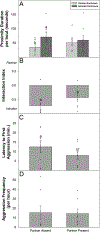Oxytocin modulates mate-guarding behavior in marmoset monkeys
- PMID: 30342885
- PMCID: PMC6298842
- DOI: 10.1016/j.yhbeh.2018.10.009
Oxytocin modulates mate-guarding behavior in marmoset monkeys
Abstract
In socially-monogamous species, intolerance of interactions between a pairmate and a sexual rival (i.e., mate-guarding) promotes the preservation of long-lasting partnerships. One promising neurobiological candidate for the regulation of mate-guarding behavior in monogamous primates is the oxytocin (OT) system, given its established role in both the development of monogamous bonds and the behavioral processes that facilitate the preservation of those bonds. In this study, male and female marmosets were exposed to a same-sex intruder in their home environment during conditions when their pairmate was present and absent, and across three treatment conditions (OT receptor agonist; saline control; OT receptor antagonist). Saline-treated marmosets spent significantly more time in proximity to the intruder, relative to the empty pairmate enclosure, when their pairmate was absent. However, when marmosets received OT they spent less time in proximity to the intruder, indicating that OT may reduce interest in a same-sex stranger in a territorial context. When their pairmate was present, saline-treated marmosets spent equal time in proximity to both intruder and pairmate; yet when they received OT they spent significantly more time in proximity to the intruder, indicating that OT may increase interest in a same-sex stranger in a mate-guarding context. While OT treatment did not directly influence the expression of aggression, OT system manipulations impacted the expression of selective social interest during an intruder challenge, suggesting that OT may enhance adaptive responses to social challenges. Moreover, these findings add to the converging evidence that the OT system regulates behavioral processes that underlie the preservation of established relationships.
Keywords: Aggression; L-368,899®; Mate-guarding; Monogamy; Oxytocin; Pairbond; Primates; Pro(8)-OT; Sociality.
Copyright © 2018 Elsevier Inc. All rights reserved.
Figures





References
-
- Alberts SC, Buchan JC, Altmann J, 2006. Sexual selection in wild baboons: from mating opportunities to paternity success. Anim. Behav 72, 1177–1196. 10.1016/j.anbehav.2006.05.001 - DOI
-
- Anzenberger G, Mendoza SP, Mason WA, 1986. Comparative studies of social behavior in Callicebus and Saimiri: Behavioral and physiological responses of established pairs to unfamiliar pairs. Am. J. Primatol 11, 37–51. - PubMed
-
- Arlet ME, Molleman F, Chapman CA, 2008. Mating Tactics in Male Grey-Cheeked Mangabeys (Lophocebus albigena). Ethology 114, 851–862. 10.1111/j.1439-0310.2008.01533.x - DOI
-
- Baker AJ, Dietz JM, Kleiman DG, 1993. Behavioural evidence for monopolization of paternity in multi-male groups of golden lion tamarins. Anim. Behav 46, 1091–1103.
Publication types
MeSH terms
Substances
Grants and funding
LinkOut - more resources
Full Text Sources

